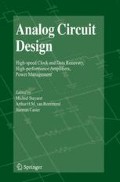Abstract
Although distortion is a key characteristic of class-D audio amplifiers, in practice most design effort is spent on robustness and the mitigation of audible artifacts. This paper explores some topics from these relatively unfamiliar areas of design. The switching nature of class-D amplifiers involves problems and solutions that are typical for class-D.
Access this chapter
Tax calculation will be finalised at checkout
Purchases are for personal use only
Preview
Unable to display preview. Download preview PDF.
References
K. Nielsen, “A review and comparison of pulse width modulation (PWM) methods for analog and digital switching power amplifiers”, 102nd Conv. AES, 1997.
M. Berkhout “Clock Jitter in Class-D Audio Power Amplifiers”, Proceedings ESSCIRC 2007, pp. 444–447, September 2007.
C. Neesgaard, et al. “Class D Digital Power Amp (PurePath DigitalTM) High Q Musical Content”, Proceedings ISPSD 2004, pp. 97–100. 2004.
P. van der Hulst, A. Veltman and R. Groeneweg, “An asynchronous switching high-end power amplifier” 112th Conv. AES, 2002.
M. Berkhout, “An integrated 200-W Class-D audio amplifier”, Journal of Solid-State Circuits, vol. 38, No.7, pp. 1198–1206, November 2003.
M. Berkhout, “Integrated Overcurrent Protection System for Class-D Audio Power Amplifiers”,Journal of Solid-State Circuits, vol. 40, No. 11, pp. 2237–2245, November 2005.
P. Wessels, et al. “Advanced BCD technology for automotive audio and power applications”, Solid-State Electronics, No. 51. pp. 195–211, 2007
P. Morrow, E. Gaalaas and O. McCarthy, “A 20-W stereo class-D audio output stage in 0.6 mm BCDMOS technology”, Journal of Solid-State Circuits, vol. 39, No. 11, pp. 1948–1958, November 2004.
M. Berkhout, “A Class-D Output Stage with Zero Dead Time”, ISSCC Dig. Tech. Papers, pp. 134–135, Februari 2003.
F. Nyboe, et al., “A 240 W Monolithic Class-D Audio Amplifier Output Stage”, ISSCC Dig. Tech. Papers, pp. 1346–1355, Februari 2006.
Author information
Authors and Affiliations
Editor information
Editors and Affiliations
Rights and permissions
Copyright information
© 2009 Springer Science+Business Media, LLC
About this chapter
Cite this chapter
Berkhout, M. (2009). Design of High Power Class-D Audio Amplifiers. In: Steyaert, M., Roermund, A.H.v., Casier, H. (eds) Analog Circuit Design. Springer, Dordrecht. https://doi.org/10.1007/978-1-4020-8944-2_12
Download citation
DOI: https://doi.org/10.1007/978-1-4020-8944-2_12
Publisher Name: Springer, Dordrecht
Print ISBN: 978-1-4020-8943-5
Online ISBN: 978-1-4020-8944-2
eBook Packages: EngineeringEngineering (R0)

